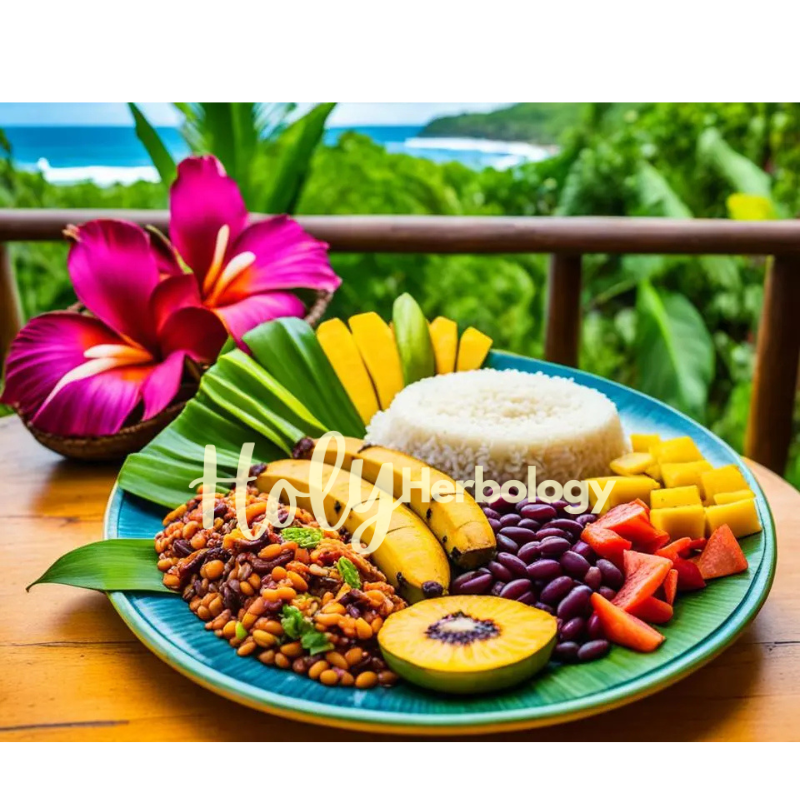
Could Costa Rica’s Traditional Food Practices Hold the Answer to America’s Health Crisis?
America’s health crisis has reached unprecedented levels, with chronic diseases like obesity, diabetes, and fatigue becoming the norm. As I sit here at El Cafe de LC in Grecia Costa Rica writing this article and chowing down on a soft flaky baguette and sipping on their refreshing tap water, I noticed something remarkable: not only did I feel more energized and satisfied when I consume my meals here in Costa Rica, but the food didn’t leave me feeling sluggish as it often does back in the States. Is there something unique about Costa Rican food practices or is there something uniquely hidden about American food practices? Could Costa Rica’s traditional food practices hold the key to a healthier America?
I know it can be hard for most because I couldn’t see this at all before my first visit to Costa Rica, but try to imagine a place where fresh fruit smoothies are cheaper than sodas, where restaurant menus change with the seasons, and the food you eat leaves you feeling energized rather than exhausted. This isn’t a fantasy—this is daily life in Costa Rica and it still can be in the States too. Since spending time here, I’ve noticed profound differences between how Costa Rica approaches food and health compared to the U.S. But the most shocking realization? It’s almost as if you have to pay more to get sick here in Costa Rica, while fresh, nutrient-rich options are not only affordable but the norm.
The American Health Crisis: Could We Be Missing the Obvious?
America’s relationship with food is, to put it lightly, complicated. Chronic diseases like diabetes, heart disease, and obesity are skyrocketing, and studies have shown that diets high in processed foods are a major contributor. Yet, access to healthy food is increasingly out of reach for many Americans. In Costa Rica, however, food doesn’t seem to come with this trade-off. Could their more traditional food practices be part of the solution?
The Power of Traditional Food Practices in Costa Rica
Costa Rica’s traditional food practices includes an approach to food has been shaped by simplicity and a strong connection to nature. Traditional Costa Rican cuisine emphasizes:
- 1. Seasonal and Local Produce
In Costa Rica, restaurants don’t just offer fresh smoothies—they only serve fruits that are in season. This means that the smoothies you order are always made with the freshest ingredients, free from preservatives and pesticides. It’s a stark contrast to American menus, where out-of-season fruits and vegetables are often shipped in from thousands of miles away, losing quality and freshness. - 2. Fresh is Affordable
Unlike in the U.S., where sugary drinks and processed foods are often cheaper than fresh options, Costa Rican menus offer fresh fruit and vegetables with their dishes and juices at a lower price point than the processed and refined foods and drinks. Imagine walking into a restaurant and choosing a fresh mango smoothie not just because it’s healthy and straight off the tree but because it’s the budget-friendly choice. Here, it’s as if Costa Rican culture truly sees food as medicine, nourishing both body and soul without breaking the bank. In America, this reversal seems almost unimaginable.
Did You Know?
A 2021 study published in Frontiers in Nutrition found that diets rich in fresh fruits and vegetables, like those common in Costa Rica, are associated with a 30% reduction in chronic diseases. With processed foods making up nearly 60% of the American diet, could our reliance on convenience foods be eroding our health from the inside out?
This natural approach contrasts sharply with America’s reliance on processed, fast, and ultra-preserved foods, which have been linked to health concerns.
Health Experts Weigh In

Dr. Mark Hyman, a renowned American physician and functional medicine advocate, has argued for years that the “Western diet” is at the heart of the chronic disease epidemic. “The solution isn’t in a new pill or another quick fix,” he says. “It’s in our food. When we prioritize whole, fresh foods over processed options, we tap into the body’s natural healing capabilities.” In Costa Rica, this philosophy is practically woven into the culture.
Similarly, Dan Buettner, author and researcher of Blue Zones, identified the Nicoya Peninsula in Costa Rica as one of the regions where people consistently live the longest, healthiest lives. A key factor? Their diet, which is naturally low in processed foods and rich in fresh produce, beans, and grains. In Nicoya, food is a means to longevity, not just a commodity for profit.
What’s Really Happening with American Food: A Culture of Convenience or a Recipe for Illness?
America’s industrialized food system is efficient but often at a cost to quality which ultimately leads to a steep price on your health. Additives, preservatives, and synthetic ingredients are common in American food, yet rarely present in Costa Rican diets. This distinction raises critical questions:
- Why Do We Feel Sluggish After Eating in the U.S.? High-calorie, low-nutrient foods lead to energy crashes and a lack of fulfillment.
- How Do Additives Affect Us? Studies have linked common food additives to inflammation, fatigue, and even chronic diseases.
When people eat a diet rich in whole foods, they report feeling fuller longer, have more sustained energy, and experience fewer “sugar crashes.” In the U.S., our reliance on high-sugar, high-fat processed foods could be contributing to the “post-meal slump”—often called “the itis”—that leaves us feeling drained after eating. But what if this wasn’t just normal? What if food could do the opposite?
Protect Your Health with Yuka: A Powerful Tool to Expose Hidden Ingredients
In today’s world of complex ingredient lists and misleading food packaging, protecting yourself from hidden dangers in processed foods is more important than ever. One of the best tools to help you do this is Yuka, a 100% independent app that’s free from the influence of brands or ads. Yuka’s commitment to transparency and consumer empowerment makes it a unique resource—one dedicated solely to giving people like you control over the food you buy and consume.
What Makes Yuka Different?
Unlike many nutrition apps influenced by commercial interests or sponsored ads, Yuka is fully independent. This independence ensures that the product recommendations you receive are unbiased and scientifically grounded. Recognizable by its cheerful orange carrot logo, Yuka allows you to scan food barcodes and instantly receive a clear rating based on:
- Nutritional Value – Yuka assesses nutrient quality, looking at levels of protein, fiber, sugar, fat, and more to help you choose genuinely nutritious options.
- Potential Allergens – For those with allergies or sensitivities, Yuka highlights potential allergens that could otherwise go unnoticed, ensuring safer choices for people with specific dietary needs.
- Harmful Additives – Many processed foods contain artificial colors, preservatives, and additives linked to chronic health issues. Yuka flags these additives, giving you clear, actionable information about what you may be putting in your body.
But Yuka doesn’t just stop at warnings. If it identifies a product with poor nutritional or ingredient quality, it will suggest healthier, safer alternatives. This feature alone can make shopping a whole lot easier, saving you from hours spent deciphering labels and online research.
How Yuka Can Transform Your Food Choices to Mimic The Quality of Costa Rica’s Traditional Food Practices
By using Yuka, you’re taking control of your health and making informed choices. Here’s how Yuka can be a game-changer:
- Reveal Hidden Additives: Many additives are linked to long-term health risks, from digestive issues to increased cancer risk. Yuka helps you see these additives and make informed choices.
- Choose Healthier Alternatives: When Yuka finds a potentially harmful ingredient, it offers alternatives that may be more nutritious and free of unnecessary additives. This makes it easier to transition to healthier options over time.
- Enhance Wellness: Understanding what’s in your food allows you to nourish your body with high-quality ingredients, supporting vitality, longevity, and overall wellness.
- Stay Educated and Empowered: Every scan increases your knowledge of common food ingredients, giving you the tools to make better decisions without being influenced by flashy marketing or “healthy” claims that don’t tell the full story.
Get Started with Yuka Today
Getting started with Yuka is simple and free. Here’s how to use it today:
- Download the Yuka App: Available on both iOS and Android, Yuka is free to download and use.
- Scan Your First Item: Open the app, and use your phone’s camera to scan any product barcode. You’ll receive a rating, along with details on its nutritional content, allergens, and any flagged additives.
- Explore Suggested Alternatives: If Yuka identifies a problem ingredient, it’ll suggest alternative products with better ratings, helping you make a healthier choice immediately.
- Expand Your Knowledge Over Time: Use Yuka regularly while grocery shopping to build a habit of scanning and learning about new foods. Before long, you’ll feel empowered with valuable insights into the foods you eat every day.
Why Yuka Stands Out
Yuka’s uncompromised independence makes it a powerful ally in an industry filled with misleading marketing tactics. Because it isn’t sponsored, you can trust that the information it provides is intended solely to benefit you, the consumer. Yuka exists to help you avoid hidden health risks and embrace a lifestyle that values transparency and health.
With tools like Yuka at your fingertips, you can finally shop with confidence, knowing you’re choosing products that support your long-term health.
Costa Rican Diet and Longevity—The Blue Zone Connection
Costa Rica’s Nicoya Peninsula is one of the world’s five Blue Zones—regions known for an unusually high number of centenarians and low rates of chronic illness. Unlike other parts of the world, locals in Nicoya maintain health naturally through lifestyle choices deeply rooted in community, nutrition, and movement. Here, people stay active by walking to local markets, working outdoors, and prioritizing time with family and friends rather than structured exercise routines.
A key aspect of the Blue Zone lifestyle is their focus on “pura vida,” or “pure life,” which emphasizes a balanced, stress-reducing lifestyle. This philosophy affects every area of life, from the food they eat to their interactions with others. Meals are centered on locally sourced, nutrient-rich foods, like beans, corn, and tropical fruits, which not only nourish the body but also bring families together at every meal. People in Nicoya rarely consume processed foods and prefer fresh, seasonal ingredients that are free from additives.
Key takeaways from the Blue Zone lifestyle include:
- Prioritizing Natural Movement: Aim to walk more, do chores by hand, or garden. Incorporating physical activity as part of daily life eliminates the need for structured workouts.
- Eating Simple, Whole Foods: Focus on plant-based meals that are rich in nutrients and skip the packaged items. This way, you’re naturally incorporating an anti-inflammatory, disease-preventing diet.
- Building Strong Social Connections: Close bonds with friends, family, and neighbors foster emotional well-being and lower stress, crucial for longevity.
Incorporating these habits can create a balanced life without the need for intense workouts or complicated diets, bringing a touch of the Nicoya lifestyle into everyday life and promoting health naturally.
1-Week Meal Guide Inspired by Costa Rica’s Traditional Food Practices In The Blue Zone
(View our Top 7 Surprising Superfoods Proven to Prevent Cancer Naturally)
Day 1
Breakfast: Fresh fruit smoothie with mango, pineapple, and banana
Lunch: Black bean soup with rice and avocado
Dinner: Grilled fish with steamed veggies (carrots, zucchini, bell peppers)
Day 2
Breakfast: Oatmeal with cinnamon, banana, and a drizzle of honey
Lunch: Mixed bean and veggie salad with leafy greens
Dinner: Vegetable stir-fry with quinoa
Day 3
Breakfast: Papaya and mango with a side of yogurt
Lunch: Sweet potato and black bean tacos with homemade salsa
Dinner: Lentil stew with spinach, garlic, and bell pepper
Day 4
Breakfast: Fresh fruit bowl (papaya, pineapple, banana)
Lunch: Brown rice with sautéed vegetables (tomatoes, green beans) and black beans
Dinner: Sautéed plantains, beans, and salad with avocado
Day 5
Breakfast: Whole-grain toast with mashed avocado, sprinkle of chia seeds
Lunch: Chickpea salad wrap with lettuce and tomatoes
Dinner: Fish tacos with cabbage slaw and lime
Day 6
Breakfast: Smoothie with seasonal fruits, like berries or citrus
Lunch: Bean and corn salad with a lemon dressing
Dinner: Roasted vegetables with black beans over brown rice
Day 7
Breakfast: Fresh papaya or mango with a side of granola
Lunch: Quinoa salad with veggies, black beans, and avocado
Dinner: Baked sweet potatoes with a side of lentils
Daily Movement Examples
- Walk to your local farmer’s market or grocery store.
- Gardening: Spend 30 minutes tending to plants or pulling weeds.
- Household chores: Sweeping, mopping, or washing dishes by hand.
- Stretching or yoga: 10-15 minutes daily to improve flexibility.
Social Connection Tips
- Try to eat meals with family or friends.
- Call or meet with a friend or relative regularly to share stories or support each other.
By following these meals and integrating natural movement into your day, you’re embracing the Nicoya lifestyle for a healthier, more balanced life.
Did You Know?
The U.S. food system prioritizes shelf-life and cost-efficiency over nutrition, resulting in 60% of our daily calories coming from ultra-processed foods. Studies show that populations with diets high in fresh, whole foods, like those in Costa Rica, experience significantly lower rates of chronic diseases. Could it be that we are sacrificing our health for convenience?
What Can We Learn from Costa Rica’s Approach?
Costa Rica’s traditional food practices offers a model of what could be possible if we shifted our perspective on food. Imagine a country where fresh, organic options were not only accessible but affordable, where food systems supported local farmers rather than multinational corporations, and where eating was an act of health, not convenience. As America grapples with a rising health crisis, perhaps it’s time to look beyond our borders and consider that the solution to our health problems may be rooted in the wisdom of traditional food practices.
Knowledge is God. The more we understand about the way our food system impacts our health, the better equipped we are to make choices that align with true well-being. Let’s take a page from Costa Rica’s book, challenging our assumptions about health and remembering that sometimes, the simplest answers are also the most powerful.
